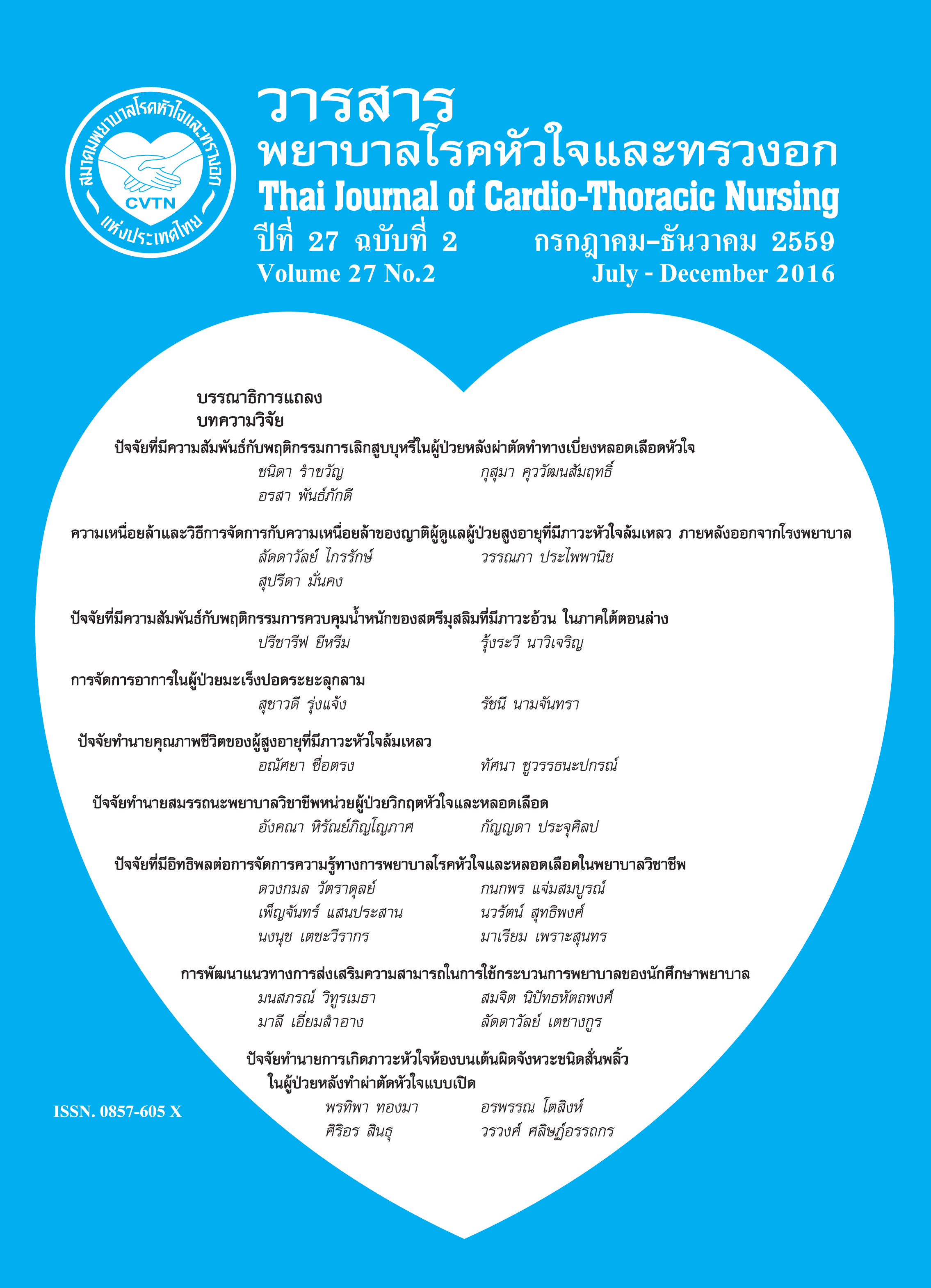ปัจจัยที่มีความสัมพันธ์กับพฤติกรรมการเลิกสูบบุหรี่ในผู้ป่วยหลังผ่าตัดทำทางเบี่ยงหลอดเลือดหัวใจ
Keywords:
พฤติกรรมการเลิกสูบบุหรี่, ผู้ป่วยหลังผ่าตัด CABG, การรับรู้ประโยชน์, การรับรู้อุปสรรค, การรับรู้สมรรถนะแห่งตน, smoking cessation behavior, patients after undergoing CABG, perceived benefits, perceived barriers, perceived self-efficacyAbstract
การวิจัยครั้งนี้เป็นการวิจัยเชิงบรรยายมีวัตถุประสงค์เพื่อศึกษาปัจจัยที่มีความสัมพันธ์ กับพฤติกรรมการเลิกสูบบุหรี่ในผู้ป่วยหลังผ่าตัดทำทางเบี่ยงหลอดเลือดหัวใจ (Coronary Artery Bypass Graft: CABG) ภายใต้กรอบแนวคิดทฤษฎีส่งเสริมสุขภาพของเพนเดอร์ กลุ่มตัวอย่าง คือ ผู้ป่วยอายุตั้งแต่ 18 ปีขึ้นไป เป็นผู้ป่วยหลังผ่าตัด CABG อย่างน้อย 6 เดือน มีประวัติการสูบบุหรี่ หรือเลิกสูบบุหรี่ จำนวน 146 คน เก็บข้อมูลผู้ป่วยที่มาตรวจตามนัดที่หน่วยตรวจผู้ป่วยนอกแผนกศัลยกรรมโรงพยาบาลรามาธิบดี โดยใช้แบบสอบถาม 2 ชุดคือ ชุดที่ 1 แบบสอบถามข้อมูลส่วนบุคคล ชุดที่ 2 แบบสอบถามความคิดและอารมณ์ที่มีต่อพฤติกรรมการเลิกสูบบุหรี่ วิเคราะห์ข้อมูลโดยการทดสอบสถิติไคสแควร์และสหสัมพันธ์แบบสเปียร์แมน
ผลการศึกษาพบว่าเพศมีความสัมพันธ์กับพฤติกรรมการเลิกสูบบุหรี่หลังผ่าตัด CABG (2 = 5.36, p <.05) และพบว่า ระดับการติดนิโคติน การรับรู้ประโยชน์ของการเลิกสูบบุหรี่ การรับรู้อุปสรรคของการเลิกสูบบุหรี่ และการรับรู้สมรรถนะแห่งตนในการเลิกสูบบุหรี่มีความสัมพันธ์ กับพฤติกรรมการเลิกสูบบุหรี่หลังผ่าตัด CABG (r = -.921, r = .316, r = -.443 และ r = .563, p <.01) ตามลำดับ
ผลการวิจัยครั้งนี้เสนอแนะว่า พยาบาลควรคำนึงถึงปัจจัย เพศ ระดับการติดนิโคติน การรับรู้ประโยชน์ของการเลิกสูบบุหรี่ การรับรู้อุปสรรคของการเลิกสูบบุหรี่และการรับรู้สมรรถนะแห่งตนในการเลิกสูบบุหรี่ เพื่อใช้ในการประเมินและการพิจารณาการแก้ไขปัญหาการสูบบุหรี่ในผู้ป่วยหลังผ่าตัด และส่งเสริมให้ผู้ป่วยสามารถเลิกบุหรี่ได้มากขึ้น ส่งผลให้ลดปัจจัยเสี่ยงเกี่ยวกับการเกิดโรคหัวใจ และลดการกลับเป็นซ้ำของโรคหลอดเลือดหัวใจได้เพิ่มขึ้น
Factors related to smoking cessation behavior among patients after coronary artery bypass graft
This research aims to describe factors related to smoking cessation behavior among patients after undergoing coronary artery bypass graft (CABG). The participants consist of 146 persons who are 18 years old and above, after undergoing CABG at least 6 months and currently smoking or smoking cessation. The data were collected at the Surgical Outpatient Clinic, Ramathibodi Hospital using the self-report questionnaire including: 1) Personal information Questionnaire 2) Smoking cessation behavior-specific cognition and affect Questionnaire. The data were analyzed by using Chi-Square test and Spearman rank correlation coefficient.
The results found that gender was related to smoking cessation behavior after CABG (2 = 5.36, p < .05) and nicotine dependence, perceived benefits of smoking cessation, perceived barriers to smoking cessation, and perceived self-efficacy in smoking cessation were related to smoking cessation behavior after CABG (r = -.921, r = .316, r = -.443 and r = .563, p <.01) respectively.
The findings of the study suggested that nurses should concern in gender, nicotine dependence, perceived benefits of smoking cessation, perceived barriers to smoking cessation, and perceived self-efficacy in smoking cessation in order to encourage patients quit smoking, reduced coronary artery disease (CAD) risk factors and reduced recurrent CAD.
Downloads
How to Cite
Issue
Section
License
บทความนี้ยังไม่เคยตีพิมพ์หรืออยู่ในระหว่างส่งไปตีพิมพ์ในวารสารอื่น ๆ มาก่อน และกองบรรณาธิการขอสงวนสิทธิ์ในการตรวจทาน และแก้ไขต้นฉบับตามเกณฑ์ของวารสาร ในกรณีที่เรื่องของท่านได้ได้รับการตีพิมพ์ในวารสารฉบับนี้ถือว่าเป็น ลิขสิทธิ์ของวารสารพยาบาลโรคหัวใจและทรวงอก





